The San Diego Padres are an American professional baseball team based in San Diego. The Padres compete in Major League Baseball as a member club of the National League West division. Founded in 1969, the club has won two NL pennants—in 1984 and 1998, losing in the World Series both years. As of 2022, they have had 16 winning seasons in franchise history. The Padres are one of two Major League Baseball teams in California to originate from the state; the Athletics were originally from Philadelphia, and the Dodgers and Giants are originally from two New York City boroughs—Brooklyn and Manhattan, respectively. As of 2022, the Padres are the only team in California not to have won a World Series.
Following the relocation of the Chargers to Los Angeles in 2017, the Padres became the only franchise in the four major American professional sports leagues in the San Diego sports market.
From 1969 through 2021, the Padres have an overall record of 3,863–4,495.
Franchise history
Pacific Coast League
The Padres adopted their name from the Pacific Coast League team that arrived in San Diego in 1936. That minor league franchise won the PCL title in 1937, led by 18-year-old Ted Williams, the future Hall-of-Famer who was a native of San Diego. The team's name, Spanish, Italian and Portuguese for "fathers", refers to the Spanish Franciscan friars who founded San Diego in 1769.
Major League Baseball
In 1969, the Padres joined the ranks of Major League Baseball as one of four new expansion teams, along with the Montreal Expos, the Kansas City Royals, and the Seattle Pilots. One of its earliest owners was C. Arnholt Smith, a prominent San Diego businessman and former owner of the PCL Padres whose interests included banking, tuna fishing, hotels, real estate and an airline. Despite initial excitement, the guidance of longtime baseball executives, Eddie Leishman and Buzzie Bavasi, as well as a new playing field, the team struggled; the Padres finished in last place in each of its first six seasons in the NL West, losing 100 games or more four times. One of the few bright spots on the team during the early years was first baseman and slugger Nate Colbert, an expansion draftee from the Houston Astros and still the Padres' career leader in home runs.
The team's fortunes gradually improved as they won five National League West titles and reached the World Series twice, in 1984 and in 1998, but lost both times. The Padres' main draw during the 1980s and 1990s was hall of famer Tony Gwynn, who won eight league batting titles. They moved into their current stadium, Petco Park, in 2004.
On August 20, 2020, the Padres became the first team in MLB history to hit a grand slam in four consecutive games earning the nickname, "Slam Diego Padres".
Until 2021, the Padres were the last team in MLB that had yet to throw a no-hitter. The record was broken on April 9, 2021, as Joe Musgrove accomplished the feat against the Texas Rangers, finally ending the longest no-hit drought by a team in MLB history. On September 5, 1997, Andy Ashby took a no-hitter into the 9th inning, which was previously the closest that the team had come to achieving this feat.
Spring training
The team has played its spring training games at the Peoria Sports Complex in Peoria, Arizona since 1994. They share the stadium with the Seattle Mariners.
From 1969 to 1993, the Padres held spring training in Yuma, Arizona at Desert Sun Stadium. Due to the short driving distance and direct highway route, Yuma was very popular with Padres fans, and many fans would travel by car from San Diego for spring training games. The move from Yuma to Peoria was very controversial, but was defended by the team as a reflection on the low quality of facilities in Yuma and the long travel necessary to play against other Arizona-based spring training teams.
Logos and colors
Throughout the team's history, the San Diego Padres have used multiple logos, uniform, and color combinations.
1969–1979: Original brown & gold
Their first logo in 1969 depicted a friar swinging a bat with Padres written at the top while standing in a sun-like figure with San Diego Padres on the exterior of it. The "Swinging Friar" has popped up on the uniform on and off ever since. Although the "Swinging Friar" is no longer used as the primary logo, it remains as the mascot of the team and is now used as an alternate logo and on the uniform sleeve.
Brown and gold were the Padres' original colors. The team's first uniforms featured a cream base for the home uniforms and a tan base for the road uniforms. Brown letters with gold trim adorned the uniforms, which featured the team name in front of both designs. A second tan uniform, this time with the city name, was used as a road alternate before becoming the primary in 1971. Caps were all-brown with the gold "SD", though the team later broke out an alternate gold cap with a brown brim and "SD" lettering.
Switching from flannel to polyester in 1972, the Padres radically changed their uniforms. The team wore all-gold uniforms and pants regardless of road or home games, with the only difference being the road uniform emblazoned with the city name and the home uniform with the team name. The Padres also broke out a new brown cap, complete with a gold front panel and a brown "SD", which would remain for the next several years. The gold front panel was shaped as a bell, alluding to the bells in the historic missions in California.
In 1974, the Padres returned to wearing traditional uniforms. The home design now had a script "Padres" lettering in front, with the road design keeping much of the original aesthetic. Chest numbers were also added. In 1976, the Padres ditched the buttons in favor of pullovers for their home uniform. In addition, they went with a brown uniform top for road games, featuring gold sleeves and gold letters.
The brown uniforms served as a template for the Padres' next uniform set beginning in 1978. The home uniforms now featured brown sleeves and gold letters, and a gold alternate with brown sleeves and letters was also released. The full team name, which was written in a more futuristic font, was emblazoned in front while the swinging friar logo was added to the left sleeve. However, this set only lasted for that season, as the Padres tweaked its design the next season. The updated design removed the swinging friar logo while returning to the team name/city name dynamic for home and road games respectively. The gold uniforms were also retired.
1980–1984: Brown, gold, & orange
In 1980, the Padres added orange to the palette. The team's next uniform set removed the contrasting colored sleeves and chest numbers, and orange was added to the letters and striping of the home uniforms and trim and striping of the road uniforms. The caps were also updated to feature orange trim on the "SD" and within the gold panel. In 1984, the Padres added the initials "RAK" on the left sleeve in honor of Ray Kroc.
1985–1990: Brown & orange pinstripes
In 1985, the Padres switched to using a script-like logo in which Padres was written sloped up. That would later become a script logo for the Padres. The team's colors were changed to brown and orange and remained this way through the 1990 season. In 1989, the Padres took the scripted Padres logo and put it in a gray ring that read "San Diego Baseball Club" with a striped center.
That same year, the Padres returned to wearing traditional buttoned uniforms. The home uniforms featured the script "Padres" in front while the road uniforms had the "SD" emblazoned on the left chest. Brown letters with orange trim and brown pinstripes adorned both uniforms. The "RAK" initials remained until 1986. An all-brown cap with the orange "SD" was used with the uniform.
1991–2003: Blue & orange
In 1991, the Padres logo was updated. The color of the ring was changed to silver, and the Padres script was changed from brown to blue. The logo only lasted one year, as the Padres changed their logo for the third time in three years, again by switching colors of the ring. The logo became a white ring with fewer stripes in the center and a darker blue Padres script with orange shadows and they also wearing blue pin stripes. In 1991, the team's colors were also changed, to a combination of orange and navy blue.
The home uniform kept the pinstripes but was changed to navy blue, which was also implemented on the letters. The road uniforms eliminated the pinstripes and added the city name in navy blue block letters with white trim and orange drop shadows. A navy cap with the "S" in white and "D" in orange was used with the uniform. The team logo was added on the left sleeve in 1996.
The Padres unveiled a navy blue alternate uniform in 1997, featuring the team name in front written in navy blue with orange drop shadows. Other features included orange numbers at the back and white piping along the chest, neck and sleeves. White chest numbers were added in 1999. Initially, the swinging friar logo was added to the left sleeve, but was removed after the 1998 season in favor of the team's primary logo which lasted until the 2000 season.
The following year, the Padres began wearing an alternate home white uniform which bore the same features as the primary home uniform minus the pinstripes and orange trim. Navy blue piping was also added. An alternate navy cap with the white "SD" was used with the uniform. This uniform became the primary in 2001, after which the pinstriped uniforms were retired following that season.
2004–2015: Blue & sand
The logo was completely changed when the team changed stadiums between the 2003 and 2004 seasons, with the new logo looking similar to home plate with San Diego written in sand font at the top right corner and the Padres new script written completely across the center. Waves finished the bottom of the plate. Navy remained but a sandy beige replaced orange as a secondary color. The team's colors were also changed, to navy blue and sa…
Eye-catching new design San Diego Padres clothing will be the perfect gift for San Diego Padres fans. Clothing on printed with unique and fancy designs, limited number of products.
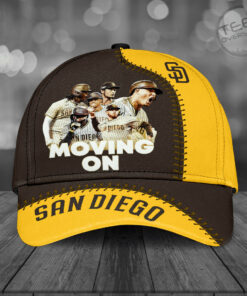
Moving On San Diego Padres Cap 3D – MLB Hat
$39.95 $29.95
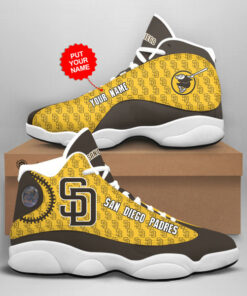
San Diego Padres shoes – MLB sneakers
$95.95 – $95.98
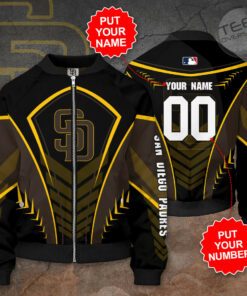
San Diego Padres Bomber Jacket – MLB Clothes
$54.95 – $54.98
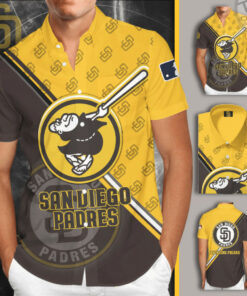
San Diego Padres Short Sleeve Shirt – MLB Clothes
$35.95 – $35.98
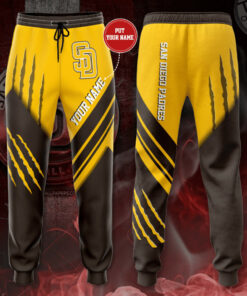
San Diego Padres Sweatpant – MLB Clothes
$45.95 – $45.98
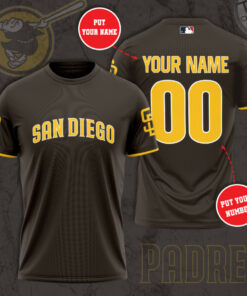
San Diego Padres T-shirt – MLB Clothes
$29.95 – $29.98

San Diego Padres Sweatshirt – MLB Clothes
$40.95 – $41.95
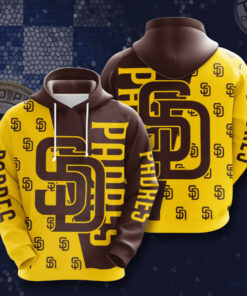
San Diego Padres Hoodie – MLB Clothes
$45.95 – $45.98
Following the relocation of the Chargers to Los Angeles in 2017, the Padres became the only franchise in the four major American professional sports leagues in the San Diego sports market.
From 1969 through 2021, the Padres have an overall record of 3,863–4,495.
Franchise history
Pacific Coast League
The Padres adopted their name from the Pacific Coast League team that arrived in San Diego in 1936. That minor league franchise won the PCL title in 1937, led by 18-year-old Ted Williams, the future Hall-of-Famer who was a native of San Diego. The team's name, Spanish, Italian and Portuguese for "fathers", refers to the Spanish Franciscan friars who founded San Diego in 1769.
Major League Baseball
In 1969, the Padres joined the ranks of Major League Baseball as one of four new expansion teams, along with the Montreal Expos, the Kansas City Royals, and the Seattle Pilots. One of its earliest owners was C. Arnholt Smith, a prominent San Diego businessman and former owner of the PCL Padres whose interests included banking, tuna fishing, hotels, real estate and an airline. Despite initial excitement, the guidance of longtime baseball executives, Eddie Leishman and Buzzie Bavasi, as well as a new playing field, the team struggled; the Padres finished in last place in each of its first six seasons in the NL West, losing 100 games or more four times. One of the few bright spots on the team during the early years was first baseman and slugger Nate Colbert, an expansion draftee from the Houston Astros and still the Padres' career leader in home runs.
The team's fortunes gradually improved as they won five National League West titles and reached the World Series twice, in 1984 and in 1998, but lost both times. The Padres' main draw during the 1980s and 1990s was hall of famer Tony Gwynn, who won eight league batting titles. They moved into their current stadium, Petco Park, in 2004.
On August 20, 2020, the Padres became the first team in MLB history to hit a grand slam in four consecutive games earning the nickname, "Slam Diego Padres".
Until 2021, the Padres were the last team in MLB that had yet to throw a no-hitter. The record was broken on April 9, 2021, as Joe Musgrove accomplished the feat against the Texas Rangers, finally ending the longest no-hit drought by a team in MLB history. On September 5, 1997, Andy Ashby took a no-hitter into the 9th inning, which was previously the closest that the team had come to achieving this feat.
Spring training
The team has played its spring training games at the Peoria Sports Complex in Peoria, Arizona since 1994. They share the stadium with the Seattle Mariners.
From 1969 to 1993, the Padres held spring training in Yuma, Arizona at Desert Sun Stadium. Due to the short driving distance and direct highway route, Yuma was very popular with Padres fans, and many fans would travel by car from San Diego for spring training games. The move from Yuma to Peoria was very controversial, but was defended by the team as a reflection on the low quality of facilities in Yuma and the long travel necessary to play against other Arizona-based spring training teams.
Logos and colors
Throughout the team's history, the San Diego Padres have used multiple logos, uniform, and color combinations.
1969–1979: Original brown & gold
Their first logo in 1969 depicted a friar swinging a bat with Padres written at the top while standing in a sun-like figure with San Diego Padres on the exterior of it. The "Swinging Friar" has popped up on the uniform on and off ever since. Although the "Swinging Friar" is no longer used as the primary logo, it remains as the mascot of the team and is now used as an alternate logo and on the uniform sleeve.
Brown and gold were the Padres' original colors. The team's first uniforms featured a cream base for the home uniforms and a tan base for the road uniforms. Brown letters with gold trim adorned the uniforms, which featured the team name in front of both designs. A second tan uniform, this time with the city name, was used as a road alternate before becoming the primary in 1971. Caps were all-brown with the gold "SD", though the team later broke out an alternate gold cap with a brown brim and "SD" lettering.
Switching from flannel to polyester in 1972, the Padres radically changed their uniforms. The team wore all-gold uniforms and pants regardless of road or home games, with the only difference being the road uniform emblazoned with the city name and the home uniform with the team name. The Padres also broke out a new brown cap, complete with a gold front panel and a brown "SD", which would remain for the next several years. The gold front panel was shaped as a bell, alluding to the bells in the historic missions in California.
In 1974, the Padres returned to wearing traditional uniforms. The home design now had a script "Padres" lettering in front, with the road design keeping much of the original aesthetic. Chest numbers were also added. In 1976, the Padres ditched the buttons in favor of pullovers for their home uniform. In addition, they went with a brown uniform top for road games, featuring gold sleeves and gold letters.
The brown uniforms served as a template for the Padres' next uniform set beginning in 1978. The home uniforms now featured brown sleeves and gold letters, and a gold alternate with brown sleeves and letters was also released. The full team name, which was written in a more futuristic font, was emblazoned in front while the swinging friar logo was added to the left sleeve. However, this set only lasted for that season, as the Padres tweaked its design the next season. The updated design removed the swinging friar logo while returning to the team name/city name dynamic for home and road games respectively. The gold uniforms were also retired.
1980–1984: Brown, gold, & orange
In 1980, the Padres added orange to the palette. The team's next uniform set removed the contrasting colored sleeves and chest numbers, and orange was added to the letters and striping of the home uniforms and trim and striping of the road uniforms. The caps were also updated to feature orange trim on the "SD" and within the gold panel. In 1984, the Padres added the initials "RAK" on the left sleeve in honor of Ray Kroc.
1985–1990: Brown & orange pinstripes
In 1985, the Padres switched to using a script-like logo in which Padres was written sloped up. That would later become a script logo for the Padres. The team's colors were changed to brown and orange and remained this way through the 1990 season. In 1989, the Padres took the scripted Padres logo and put it in a gray ring that read "San Diego Baseball Club" with a striped center.
That same year, the Padres returned to wearing traditional buttoned uniforms. The home uniforms featured the script "Padres" in front while the road uniforms had the "SD" emblazoned on the left chest. Brown letters with orange trim and brown pinstripes adorned both uniforms. The "RAK" initials remained until 1986. An all-brown cap with the orange "SD" was used with the uniform.
1991–2003: Blue & orange
In 1991, the Padres logo was updated. The color of the ring was changed to silver, and the Padres script was changed from brown to blue. The logo only lasted one year, as the Padres changed their logo for the third time in three years, again by switching colors of the ring. The logo became a white ring with fewer stripes in the center and a darker blue Padres script with orange shadows and they also wearing blue pin stripes. In 1991, the team's colors were also changed, to a combination of orange and navy blue.
The home uniform kept the pinstripes but was changed to navy blue, which was also implemented on the letters. The road uniforms eliminated the pinstripes and added the city name in navy blue block letters with white trim and orange drop shadows. A navy cap with the "S" in white and "D" in orange was used with the uniform. The team logo was added on the left sleeve in 1996.
The Padres unveiled a navy blue alternate uniform in 1997, featuring the team name in front written in navy blue with orange drop shadows. Other features included orange numbers at the back and white piping along the chest, neck and sleeves. White chest numbers were added in 1999. Initially, the swinging friar logo was added to the left sleeve, but was removed after the 1998 season in favor of the team's primary logo which lasted until the 2000 season.
The following year, the Padres began wearing an alternate home white uniform which bore the same features as the primary home uniform minus the pinstripes and orange trim. Navy blue piping was also added. An alternate navy cap with the white "SD" was used with the uniform. This uniform became the primary in 2001, after which the pinstriped uniforms were retired following that season.
2004–2015: Blue & sand
The logo was completely changed when the team changed stadiums between the 2003 and 2004 seasons, with the new logo looking similar to home plate with San Diego written in sand font at the top right corner and the Padres new script written completely across the center. Waves finished the bottom of the plate. Navy remained but a sandy beige replaced orange as a secondary color. The team's colors were also changed, to navy blue and sa…
Eye-catching new design San Diego Padres clothing will be the perfect gift for San Diego Padres fans. Clothing on printed with unique and fancy designs, limited number of products.

Moving On San Diego Padres Cap 3D – MLB Hat
$39.95 $29.95

San Diego Padres shoes – MLB sneakers
$95.95 – $95.98

San Diego Padres Bomber Jacket – MLB Clothes
$54.95 – $54.98

San Diego Padres Short Sleeve Shirt – MLB Clothes
$35.95 – $35.98

San Diego Padres Sweatpant – MLB Clothes
$45.95 – $45.98

San Diego Padres T-shirt – MLB Clothes
$29.95 – $29.98

San Diego Padres Sweatshirt – MLB Clothes
$40.95 – $41.95

San Diego Padres Hoodie – MLB Clothes
$45.95 – $45.98
Comments
Post a Comment